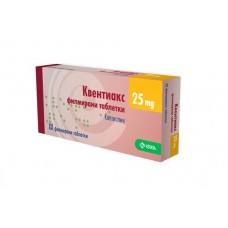Expiration date: 10/2028
Structure and Composition:
Tablets, film-coated. 1 tablet contains:
Quetiapine hemifumarate (quetiapine fumarate) 25, 100, 200 and 300 mg
Excipients: lactose monohydrate, calcium hydrogen phosphate dihydrate, sodium carboxymethyl MCC Povidone (type A), magnesium stearate
shell film: hypromellose titanium dioxide (E171) Macrogol 4000
for tablets, film-coated, 100 mg: iron oxide yellow dye (E172)
in strip cellular package (blister) 10 pcs. In the paper cartons 6 packs (blisters).
Description pharmaceutical form:
Tablets 100 mg: Round, biconvex, film-coated, light-yellow color.
Tablets 200 mg: Round, biconvex, film-coated, white color.
Tablets 300 mg: oval, biconvex, film-coated, white color.
Pharmacokinetics:
Absorption - high, it does not affect food intake on bioavailability. Binding to plasma proteins - 83%.
The pharmacokinetics of quetiapine is linear and does not differ in men and women.
Extensively metabolized in the liver with the formation of pharmacologically inactive metabolites by the enzyme cytochrome P450 CYP3A4. Quetiapine and some of its metabolites are weak inhibitors of isoenzymes 1A2, 2C9, 2C19, 2D6 and 3A4 cytochrome P450 man, but only at concentrations of at least 10-50 times higher than the concentration of the drug when used in effective doses ranging from 300 to 450 mg / d.
Based on the results of in vitro, should not be expected that co-administration of quetiapine with other drugs will result in clinically significant inhibition of cytochrome P450 mediated metabolism of other drugs. T1 / 2 is approximately 7 hours.
Report the news about 73%, and through the intestines - 21%. Less than 5% of quetiapine is not metabolized and excreted unchanged. The average clearance of quetiapine in elderly patients is 30-50% less than in patients aged 18 to 65 years. The average quetiapine plasma clearance in patients with severe renal failure (Cl creatinine <30 ml / min / 1.73 m 3) and in patients with liver disease (alcoholic cirrhosis stabilized) was reduced by about 25%.
Description of the pharmacological actions:
Mechanism of action. Quetiapine is an atypical antipsychotic, which exhibits higher affinity for serotonin receptors (5HT2) receptors than for dopamine D1 and D2 brain. Quetiapine has affinity for histamine and alpha 1-adrenoceptors and less affinity for alpha2 adrenoceptors. There were no appreciable affinity for cholinergic muscarinic to quetiapine and benzodiazepine receptors. The standard tests shows quetiapine antipsychotic activity.
Pharmacodynamic effects. The results of the study of extrapyramidal symptoms (EPS) in animals revealed that quetiapine is weak catalepsy in a dose effective blocking dopamine D2-receptors. Quetiapine is a selective decrease in the activity of the mesolimbic dopaminergic neurons in A10 versus the A9 nigrostriatal neurones involved in motor function.
The clinical efficacy. There were no differences between the use of quetiapine (at a dose of 75-750 mg / day) and placebo in the incidence of cases of extrapyramidal symptoms and concomitant use of anticholinergics. There is no long-term increase prolactin concentration in blood plasma. Quetiapine prolonged supports clinical improvement in patients who have developed a positive effect at the beginning of treatment.
Duration of effects of quetiapine on serotonin 5HT2-and the D2-dopamine receptors is less than 12 hours after taking the drug.
Indications:
- acute and chronic treatment of psychosis, including schizophrenia
- treatment of manic episodes in bipolar disorder.
Contraindications:
- Hypersensitivity to quetiapine or other ingredients
- breastfeeding
- children and adolescents up to 18 years (effectiveness and safety have been established).
Precautions: patients with cardiovascular and cerebrovascular disease, or other conditions predisposing to hypotension, inherent increase in the QT interval on the electrocardiogram (ECG), or under the conditions with the potential to cause an increase in the interval QT (co-administration of drugs prolonging the interval QT, congestive heart failure , hypokalemia, hypomagnesemia), advanced age, liver failure, epilepsy, seizures in history, pregnancy.
Application of pregnancy and breastfeeding:
The safety and efficacy of quetiapine in pregnant women has not been established. Therefore, quetiapine during pregnancy can only apply if the expected benefit justifies the potential risk.
The degree of excretion of quetiapine with mother's milk is not installed. Women should be advised to avoid breast-feeding while taking quetiapine.
Side effect:
Very often -> 1/10 - by> 1/100 to <1/10 uncommon - of> 1/1000 to <1/100 rarely - from> 1/10000 to <1/1000 very rare - from <1 / 10,000, including isolated reports.
On the part of the blood and lymphatic system: often - leukopenia, rarely - very rarely eosinophilia - neutropenia.
Disorders of metabolism and nutrition: often - increased body weight (especially in the first weeks of treatment), very rarely - hyperglycemia or diabetes decompensation.
On the part of the central and peripheral nervous system: very often - dizziness, drowsiness, headache often - infrequently syncope - anxiety, agitation, insomnia, akathisia, tremor, convulsions, depression, paresthesia, rarely - tardive dyskinesia.
Since the cardiovascular system: often - tachycardia, orthostatic hypotension, QT prolongation on the ECG.
From the respiratory system: rhinitis, pharyngitis.
On the part of the digestive tract: often - dry mouth, constipation, diarrhea, dyspepsia, rarely - jaundice, nausea, vomiting, abdominal pain: very rarely - hepatitis.
Allergic reactions: seldom - skin rash, hypersensitivity reactions are very rare - angioedema, Stevens-Johnson syndrome.
Reproductive system and breast: rarely - priapism (painful erection).
Other: often - peripheral edema, asthenia rarely - back pain, chest pain, low-grade fever, myalgias, dry skin, impaired vision, neuroleptic malignant syndrome (hyperthermia, altered mental status, muscular rigidity, autonomic-vascular disorders, increased creatine phosphokinase concentrations) .
Laboratory tests: often - increase the level of serum transaminases (ACT or ALT) rarely - increase of serum GGT and triglycerides (not fasting), hypercholesterolemia, lowering of thyroid hormones: the total T4 and free T4 (in the first 4 weeks), and - total T3 and rT3 (only with high doses of quetiapine).
Drug Interactions:
Quetiapine does not cause induction of liver enzyme systems involved in the metabolism of phenazone and lithium.
Co-administration of quetiapine with drugs that potentially inhibit hepatic enzymes (such as carbamazepine or phenytoin), as well as barbiturates, rifampicin - may decrease plasma concentrations of quetiapine, which may require increased doses of Quentiax, depending on the clinical effect. It is also necessary to consider the abolition of phenytoin or carbamazepine or another inducer of liver enzyme system or replacement of the drug, non-inducing microsomal liver enzymes (eg valproic acid).
The main enzyme responsible for the metabolism of quetiapine cytochrome P450, - CYP3A4. The pharmacokinetics of quetiapine does not change while the use of drugs such as cimetidine (an inhibitor of P450) or fluoxetine (an inhibitor of CYP2D6 and CYP3A4), an antidepressant imipramine (an inhibitor of CYP2D6).
It is recommended to exercise caution while quetiapine and systemic administration of CYP3A4 inhibitors (azole antifungals group and macrolide antibiotics), because quetiapine plasma concentrations may be increased. Therefore, you should use a lower dose of quetiapine. Particular attention should be given to the elderly and immunocompromised patients.
The pharmacokinetics of quetiapine were not significantly altered when administered simultaneously with antipsychotic drugs - risperidone or haloperidol. However, concomitant use of quetiapine with thioridazine led to an increase in the clearance of quetiapine.
Drugs that suppress the central nervous system, and ethanol increase the risk of side effects.
Dosage and administration:
Inside, 2 times a day regardless of the meal.
Treatment of acute and chronic psychosis, including schizophrenia. The daily dose of the day is the first 4: 1 day - 50 mg Day 2 - 200 mg of 3-day - 200 mg, and Day 4 - 300 mg. Starting from the fourth day, the daily dose - 300 mg. Depending on the clinical effect and tolerability of the dose may vary individually from 150 to 750 mg / day. The maximum daily dose for the treatment of schizophrenia - 750 mg.
Treatment of manic episodes in bipolar disorder. Quetiapine is recommended as monotherapy or as adjunctive therapy to mood stabilization. The daily dose of the day is the first 4: 1 day - 100 mg day 2 - 200 mg of 3-day - 300 mg, and Day 4 - 400 mg. Increasing daily dose may subsequently 200 mg / day and the 6th day of treatment it is 800 mg. Depending on the clinical effect and tolerability of the dose may vary individually from 200 to 800 mg / day. Typically, the effective dose is from 400 to 800 mg / day. The maximum daily dose for this indication - 800 mg.
Elderly age. Because plasma clearance of quetiapine in the elderly is reduced by 30-50%, should be prescribed the drug with caution, especially at the beginning of therapy. Starting dose - 25 mg / day, followed by an increase to 25-50 mg to achieve an effective dose.
Renal and hepatic insufficiency. In patients with renal and hepatic impairment is recommended to start therapy with 25 mg / day. Further it is recommended to increase the dose of 25-50 mg daily to achieve an effective dose.
Overdose:
Data on overdose of quetiapine limited. Cases of quetiapine in doses exceeding '30 In most patients, side effects are not observed in the case of the development of side effects were on their own. Joined case of death when taking 13.6 grams of quetiapine. Very rarely reported cases of quetiapine overdose leads to a lengthening of the QT interval, coma or death. In patients with severe cardiovascular disease in the history of the risk of side effects may increase in overdose.
Symptoms: excessive sedation, somnolence, tachycardia, decreased blood pressure.
Treatment: symptomatic measures aimed at maintaining respiratory function, cardiovascular system, adequate oxygenation and ventilation. No specific antidote.
Special instructions:
With a sharp lifting of high doses of antipsychotic drugs following acute reactions may occur ( "cancellation" syndrome) - nausea, vomiting, insomnia rarely. Reported cases of exacerbation of psychotic symptoms and the emergence of involuntary movement disorders (akathisia, dystonia, dyskinesia). In connection with the abolition of the drug is recommended to be made gradually.
In the appointment of quetiapine in conjunction with drugs, prolongs the QT interval, care must be taken, especially in the elderly, in congestive heart failure, with hypokalemia and hypomagnesemia.
Given that quetiapine affects the central nervous system, the drug should be used with caution in combination with other drugs having a depressing effect on the central nervous system. It is recommended to abstain from alcohol.
If symptoms of tardive dyskinesia should reduce the dose or discontinue the use of quetiapine.
seizures
In controlled clinical trials there was no difference found in the incidence of seizures between quetiapine and placebo. However, as well as in the treatment of other antipsychotics, it is recommended to use caution when treating patients with the presence of seizures in history.
Neuroleptic malignant syndrome. Neuroleptic malignant syndrome may be associated with antipsychotic treatment conducted. The clinical manifestations of the syndrome include: hyperthermia, altered mental status, muscular rigidity, instability of the autonomic nervous system, increased creatine phosphokinase levels. With the development of this syndrome quetiapine should be discontinued and appropriate treatment.
Effects on ability to drive a car or other mechanical means. During treatment with quetiapine is recommended to be careful when driving vehicles and occupation of other potentially hazardous activities that require high concentration and psychomotor speed reactions.





